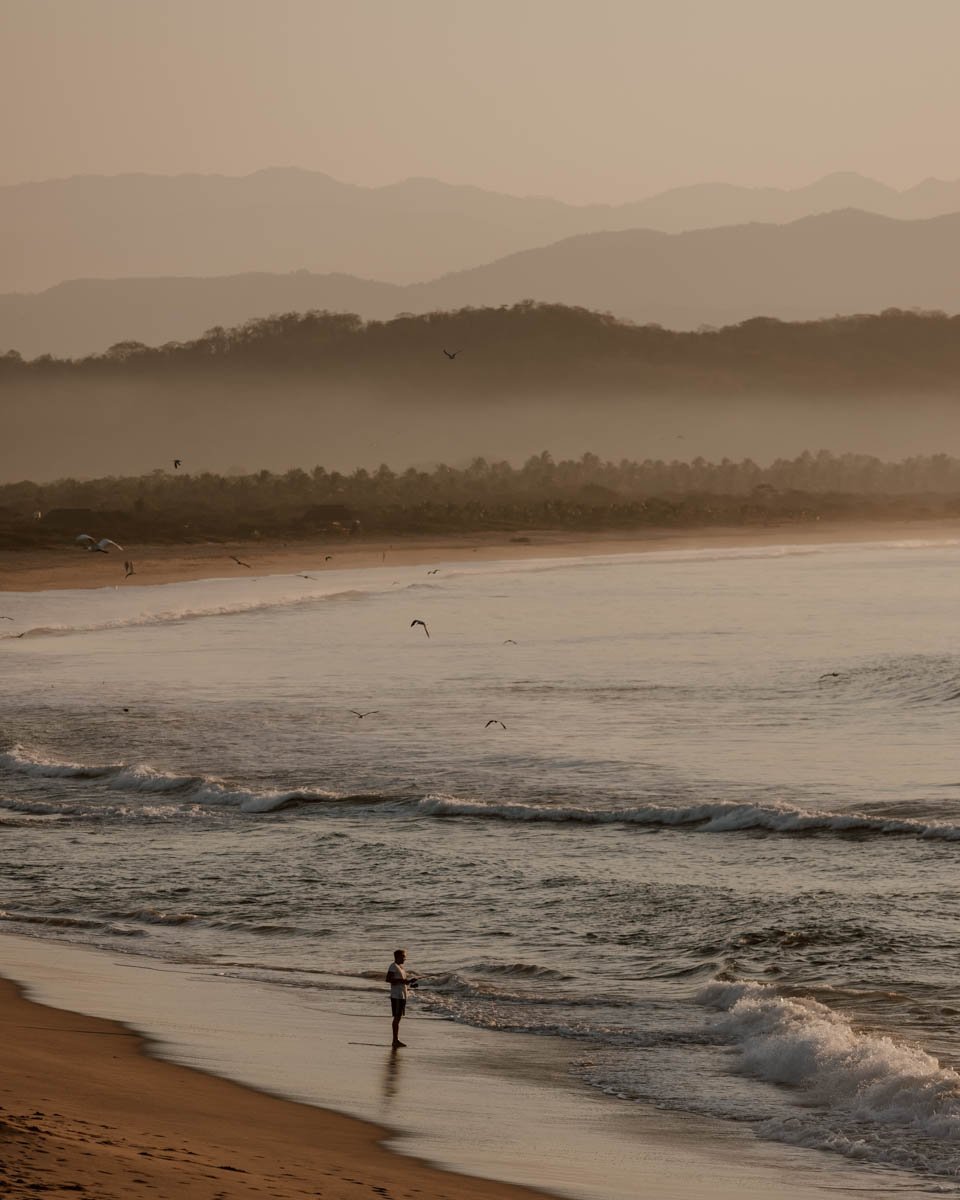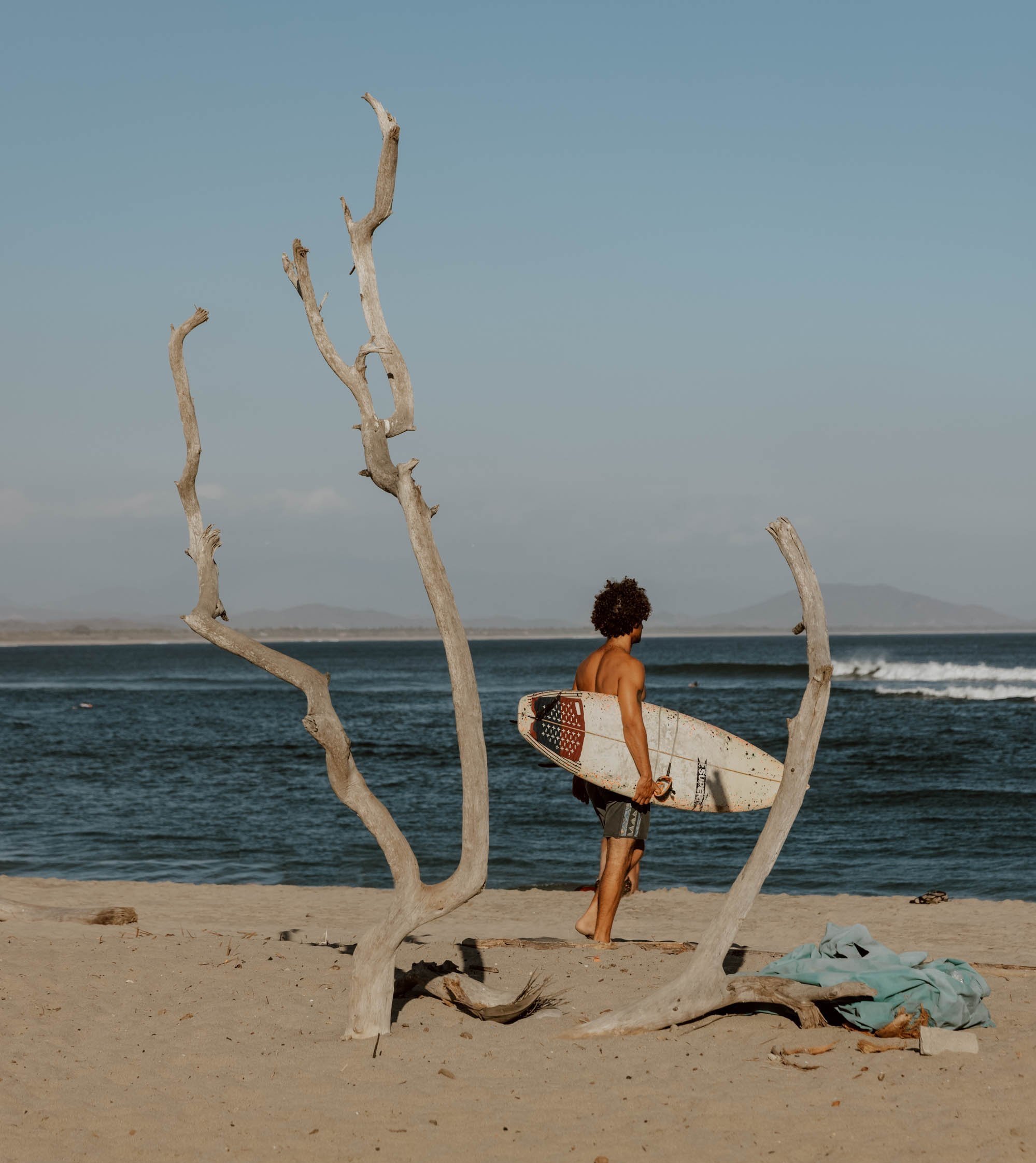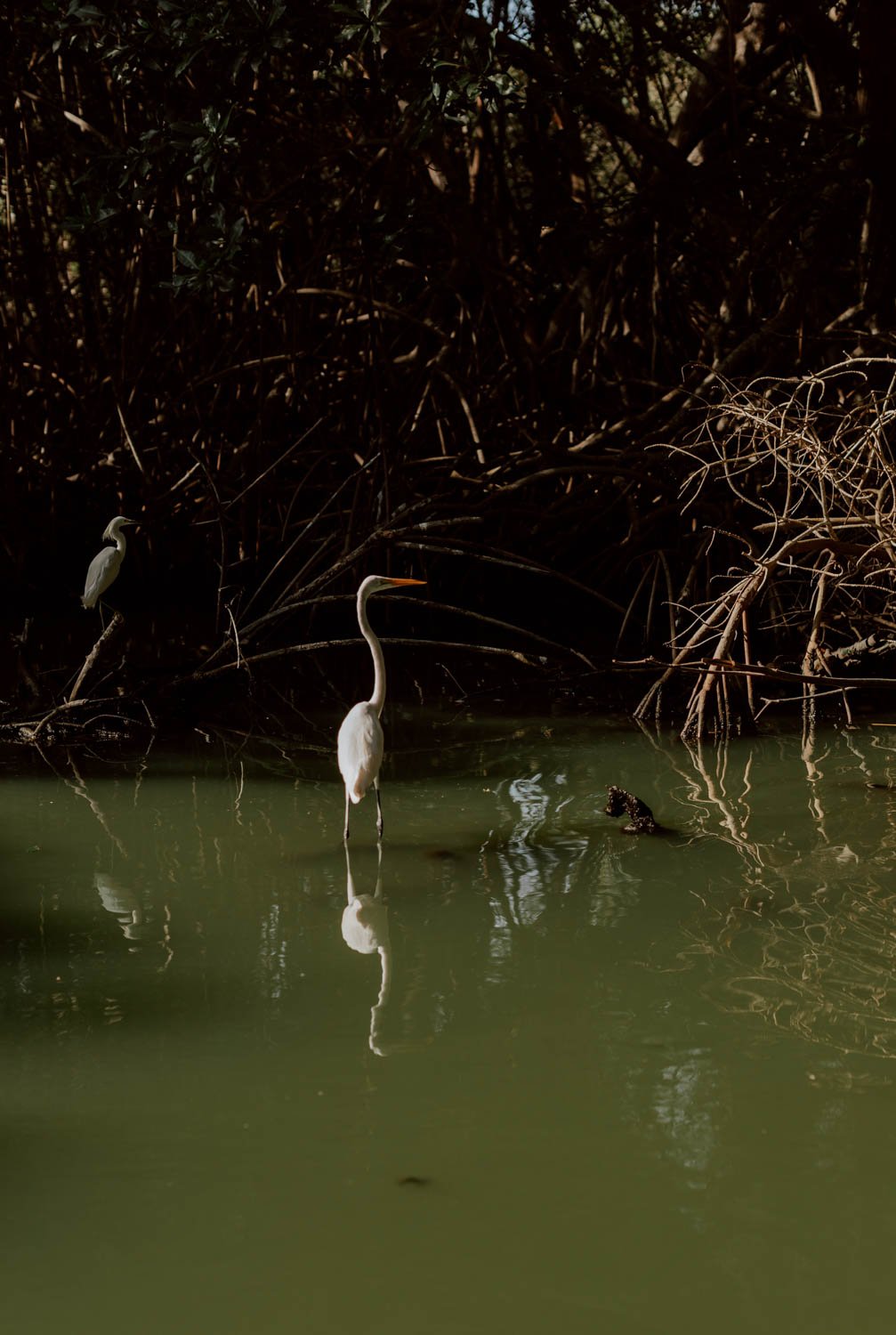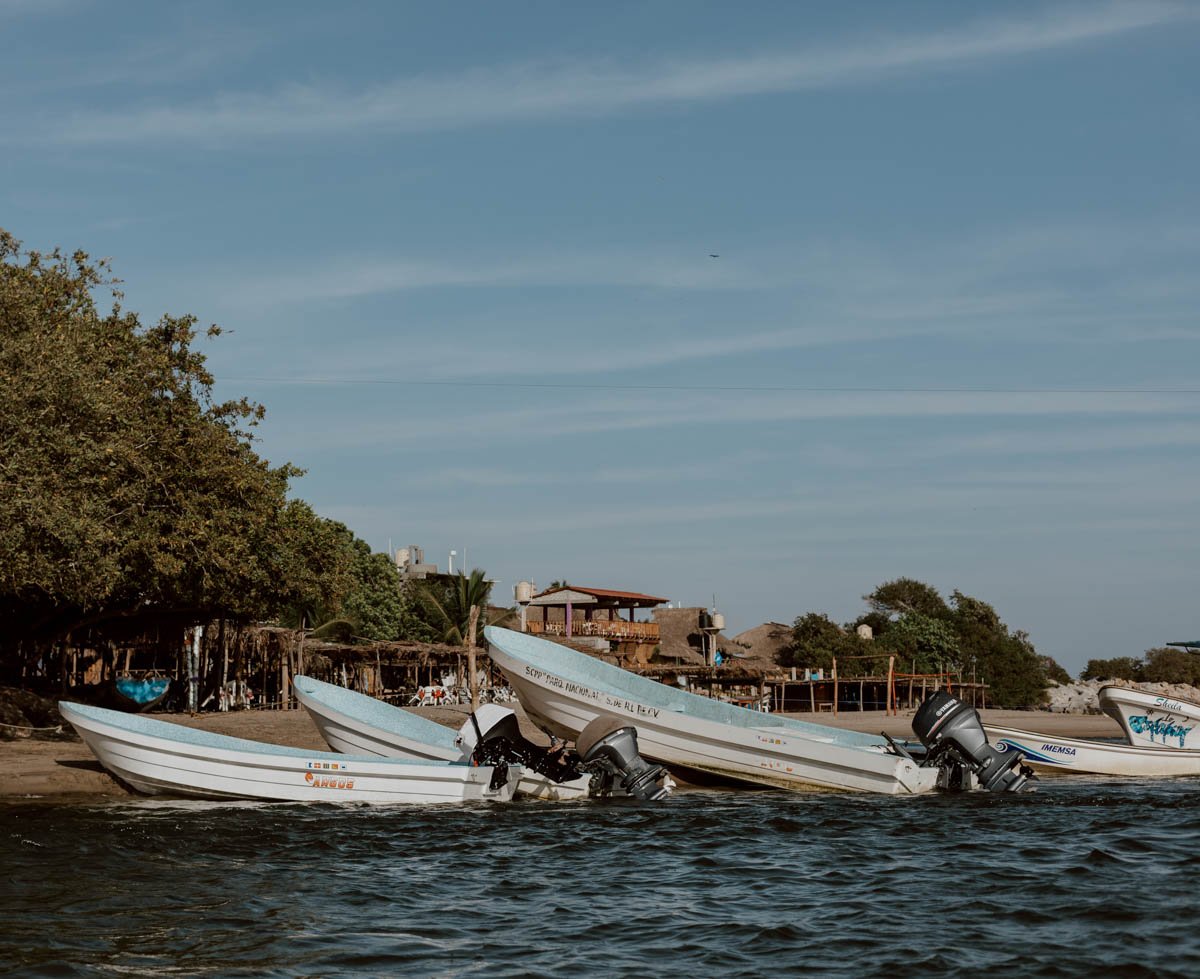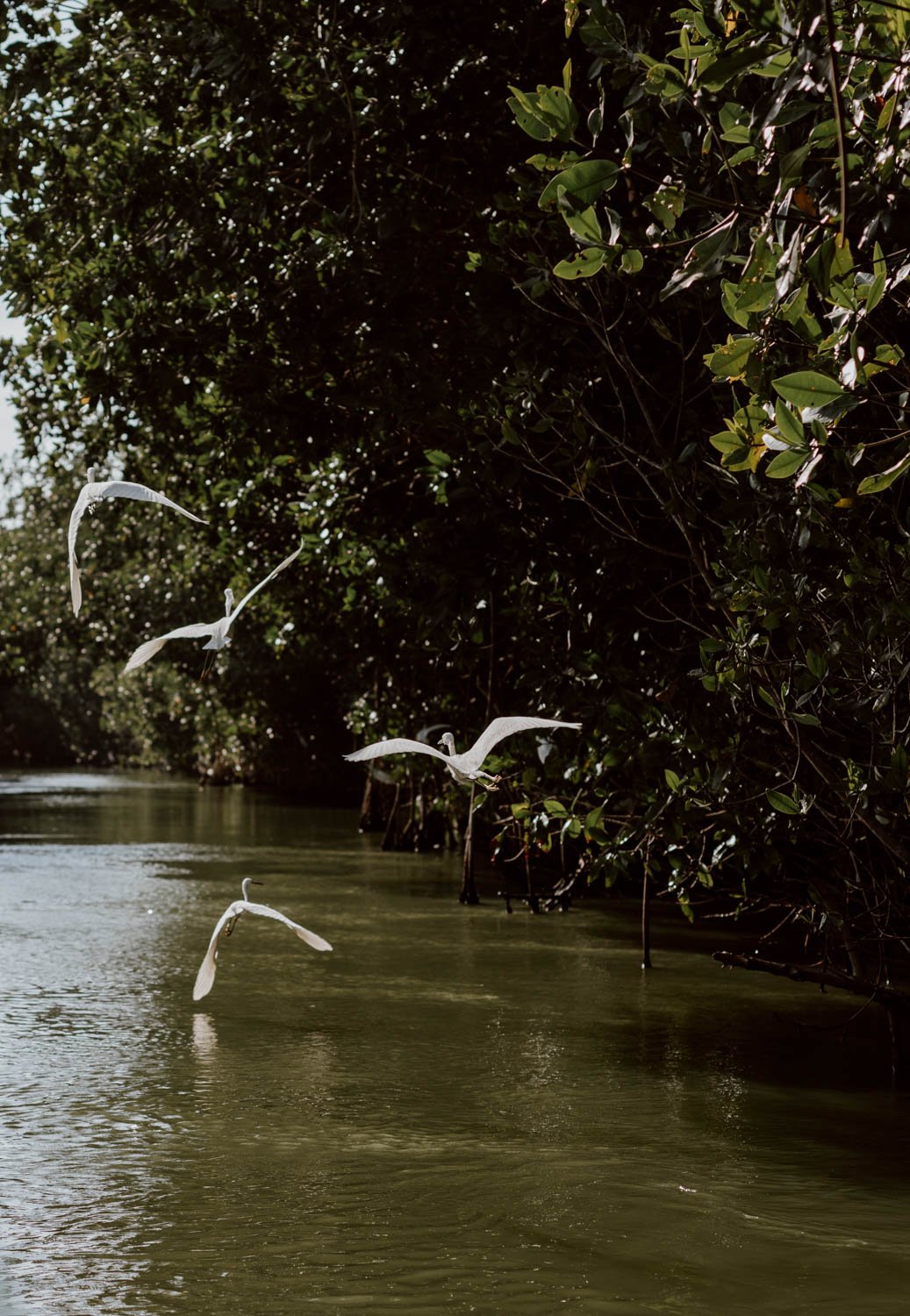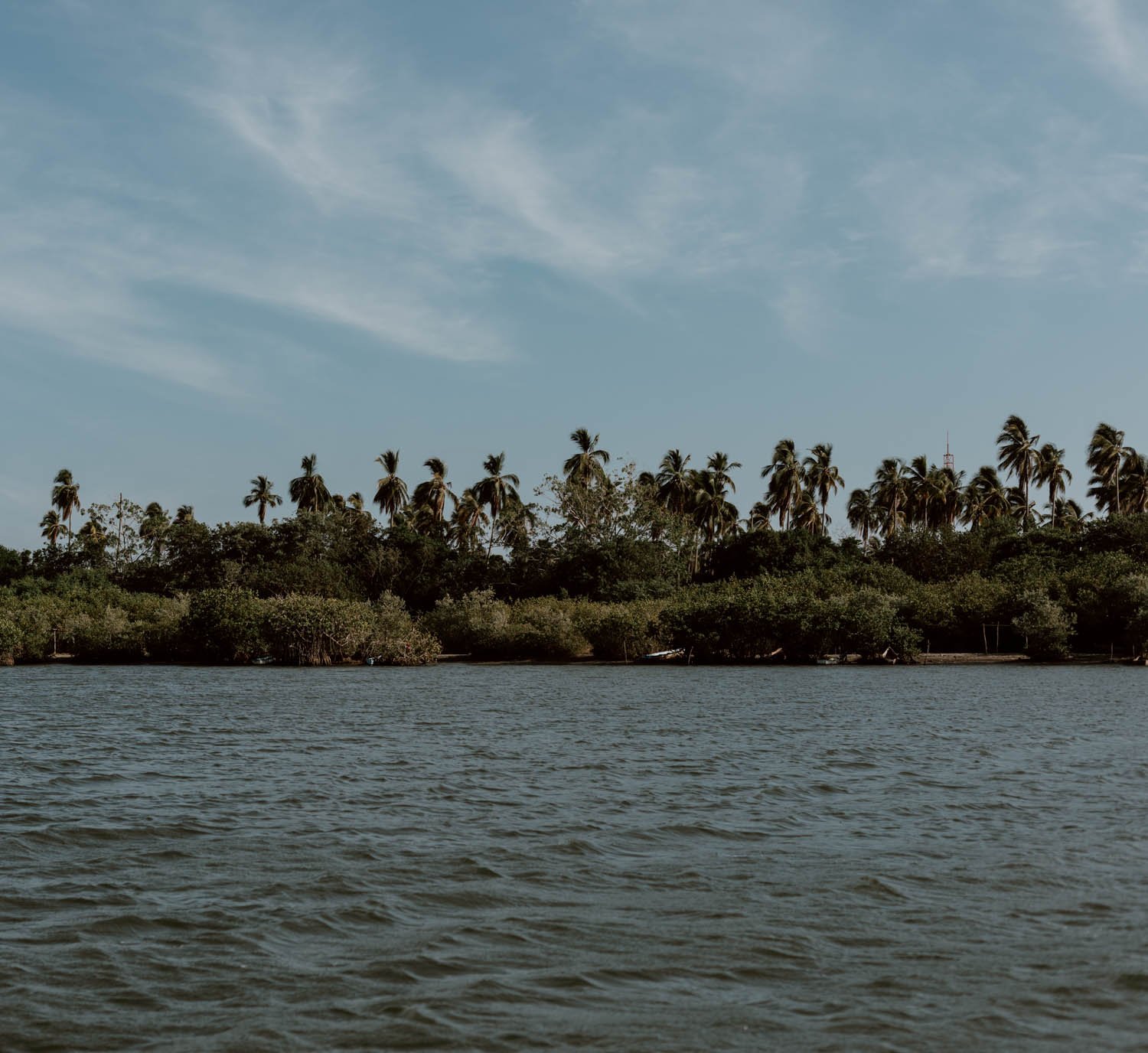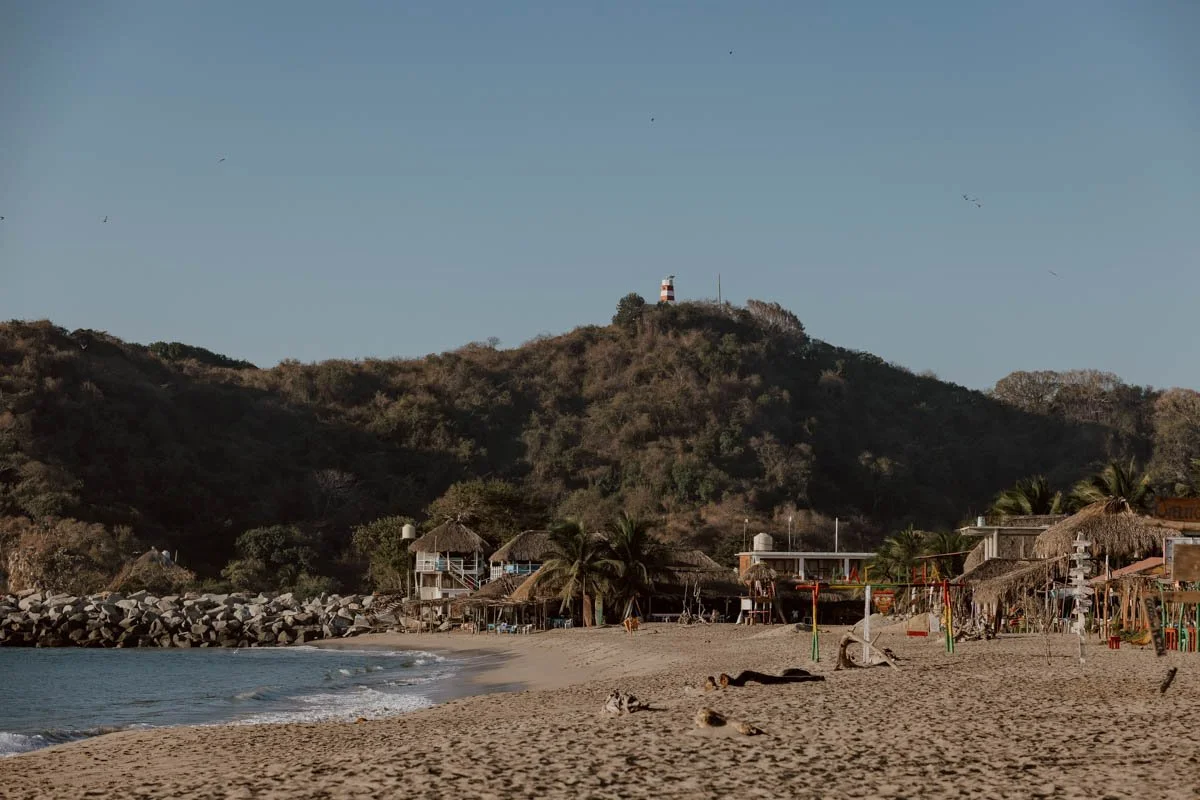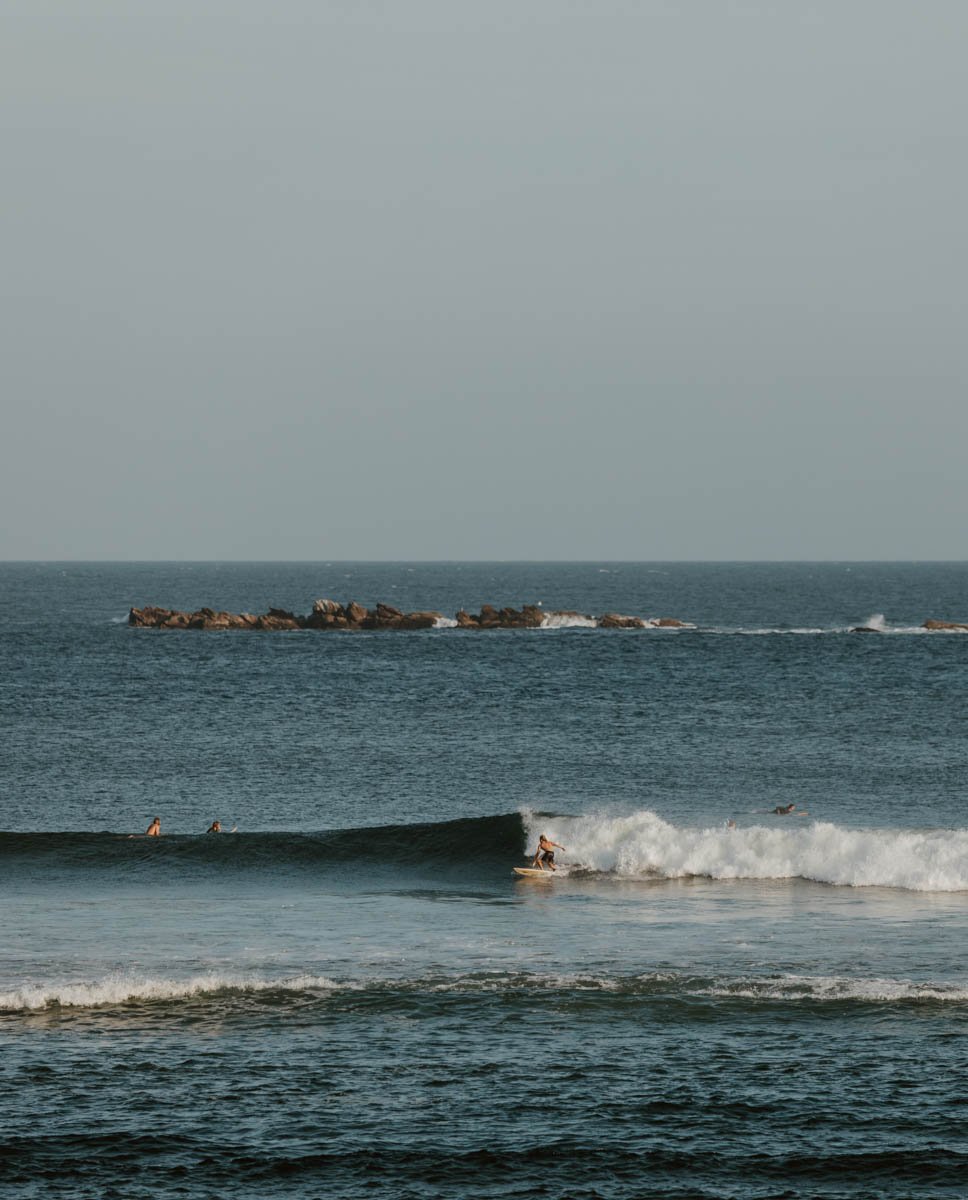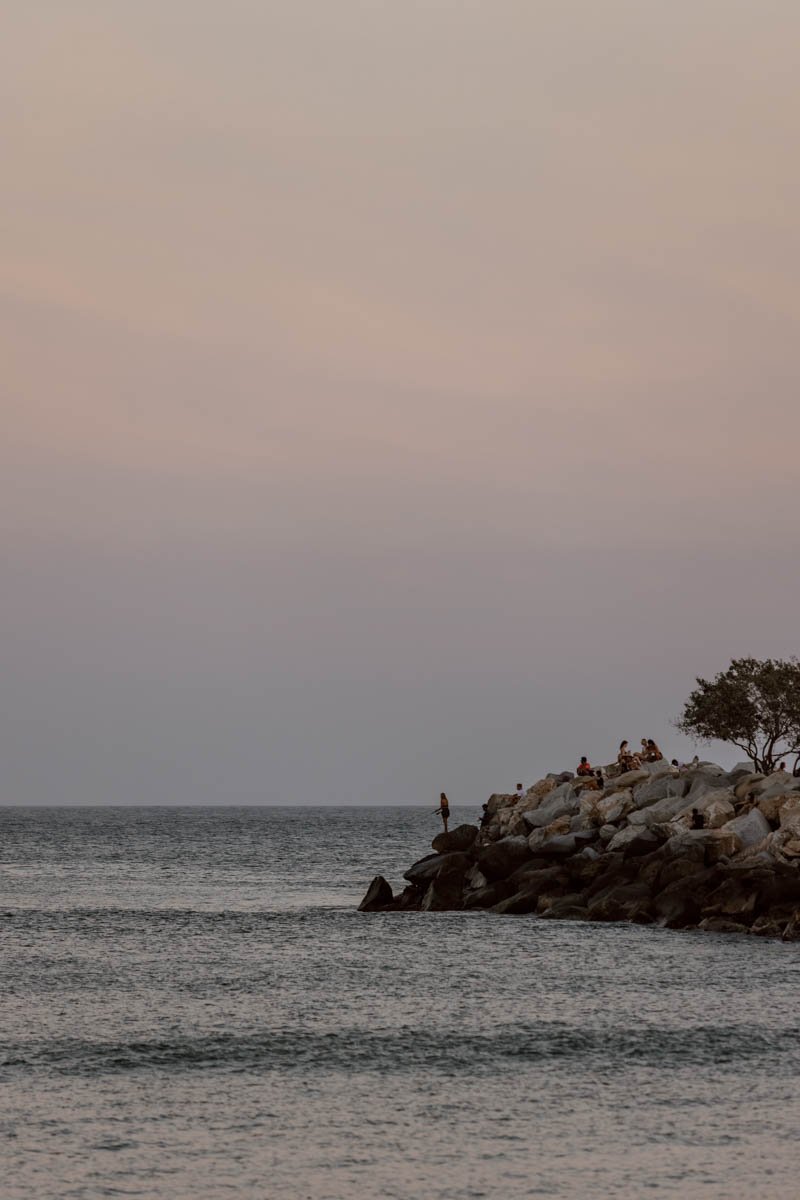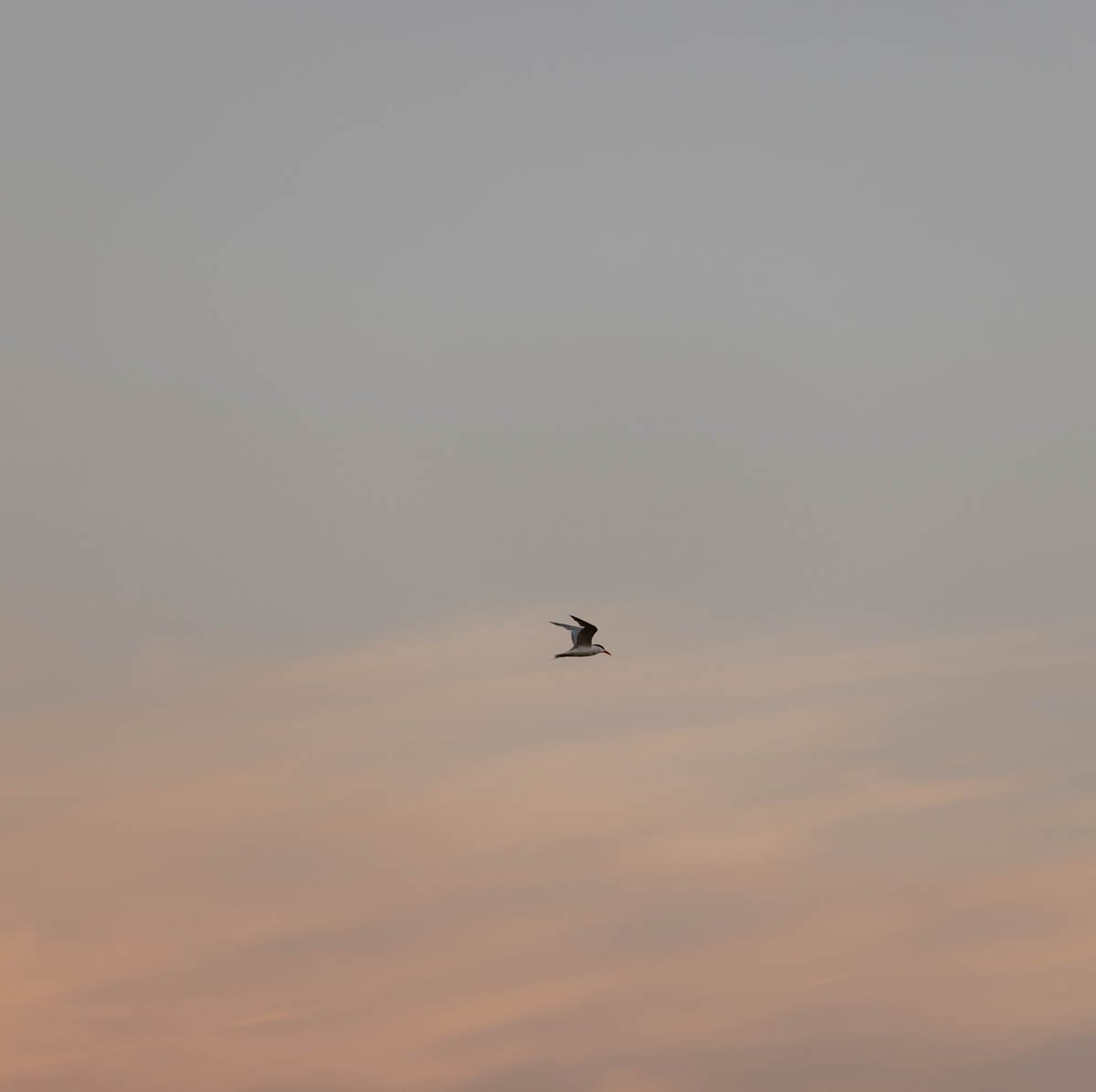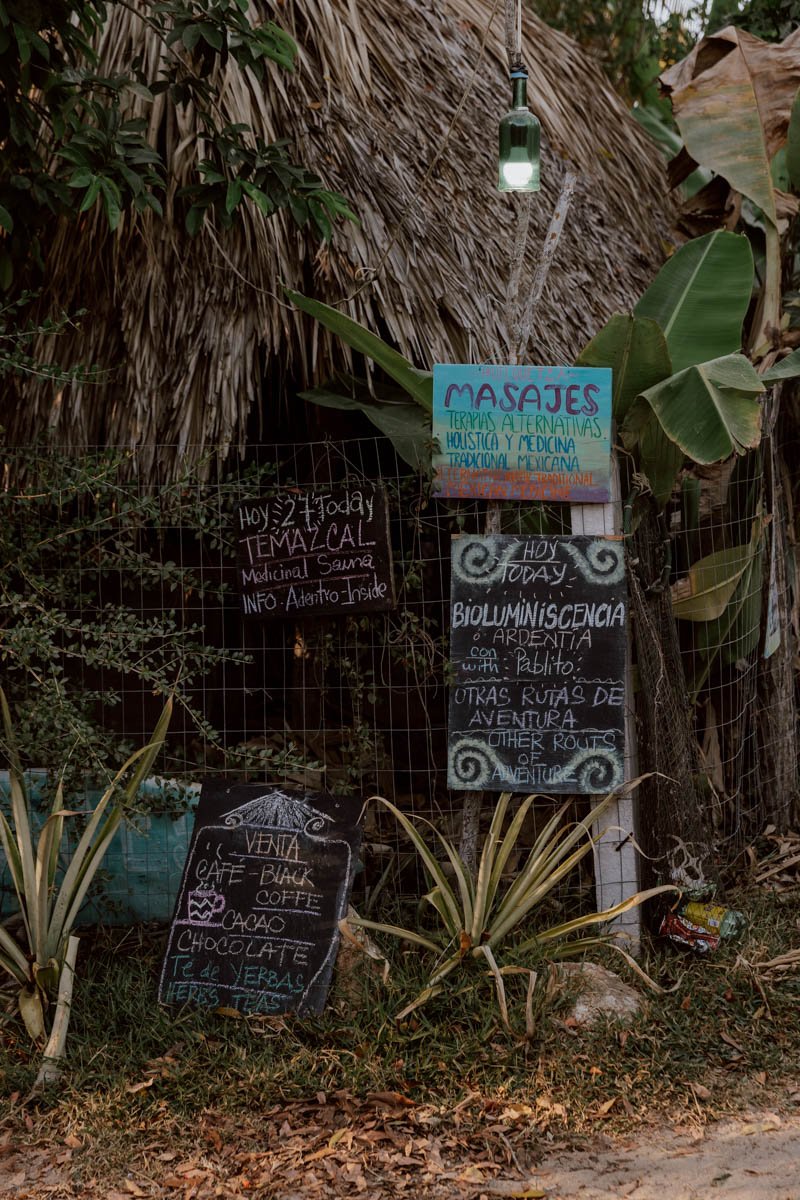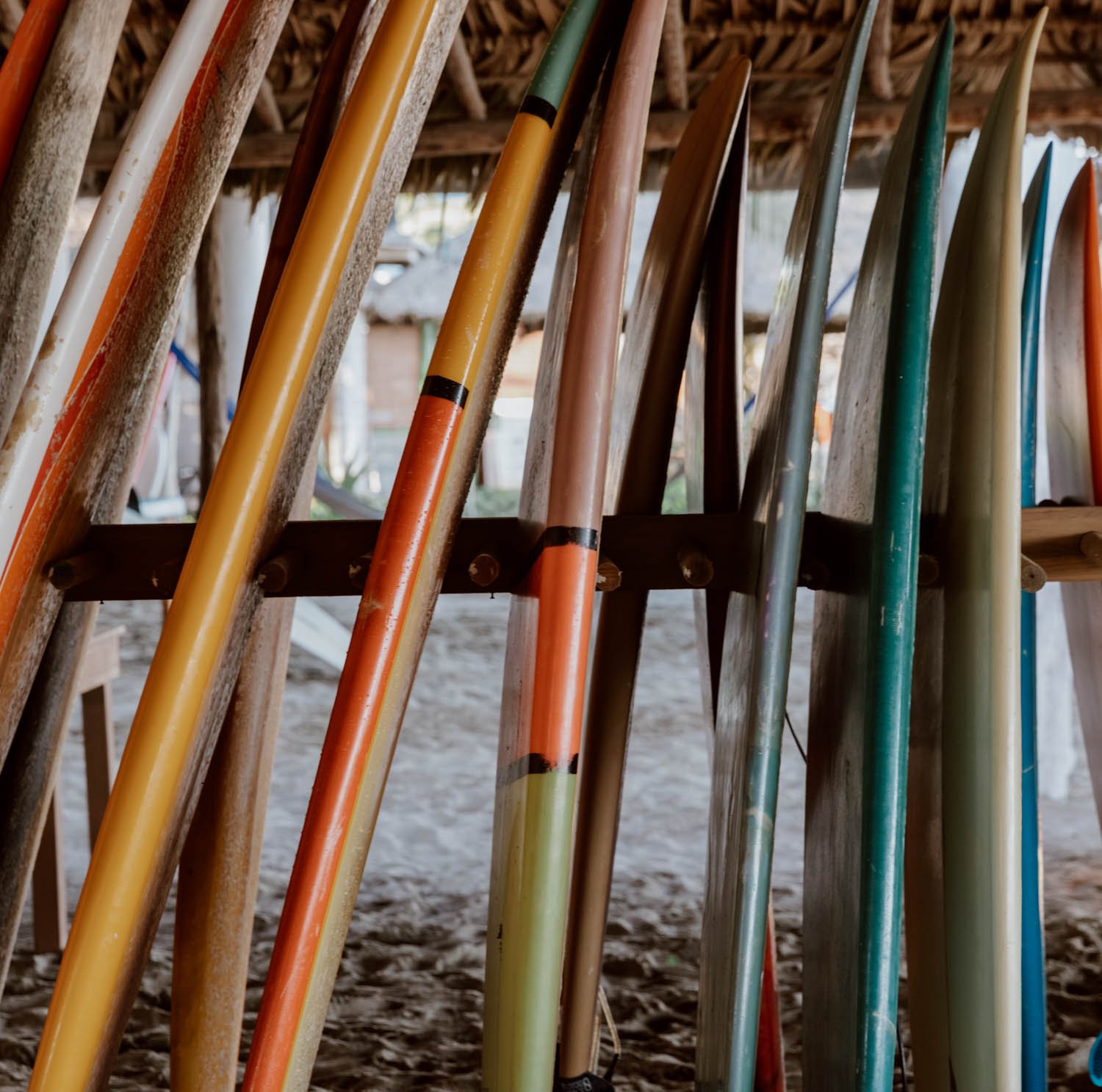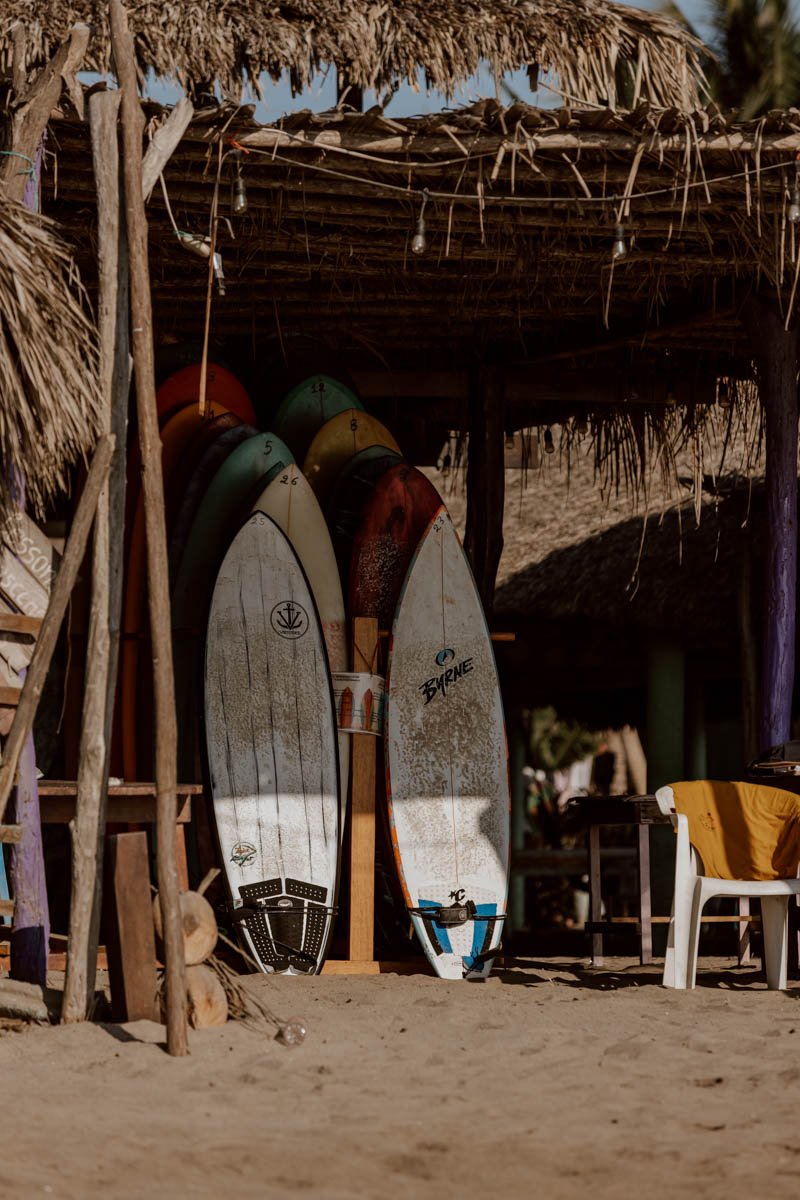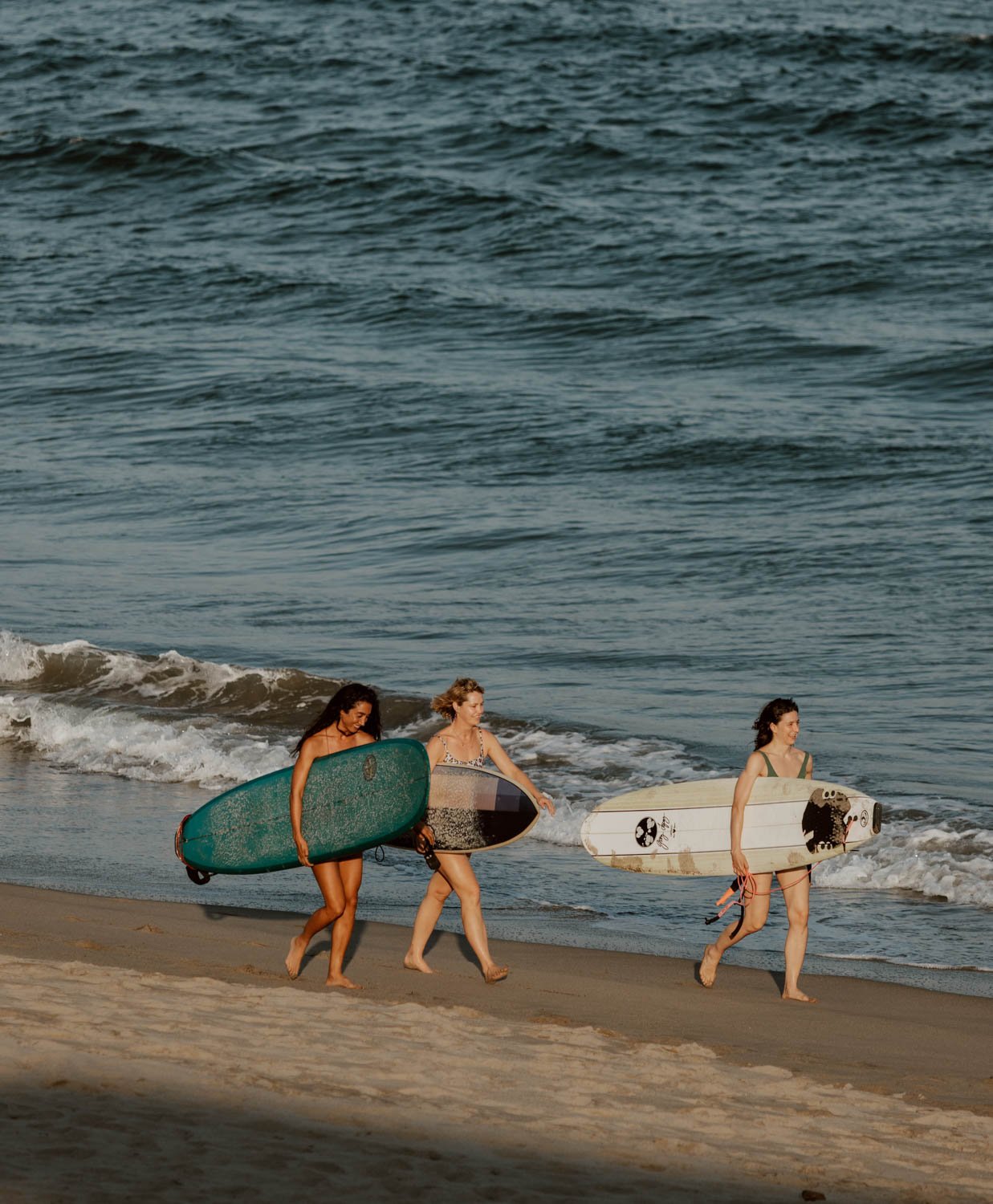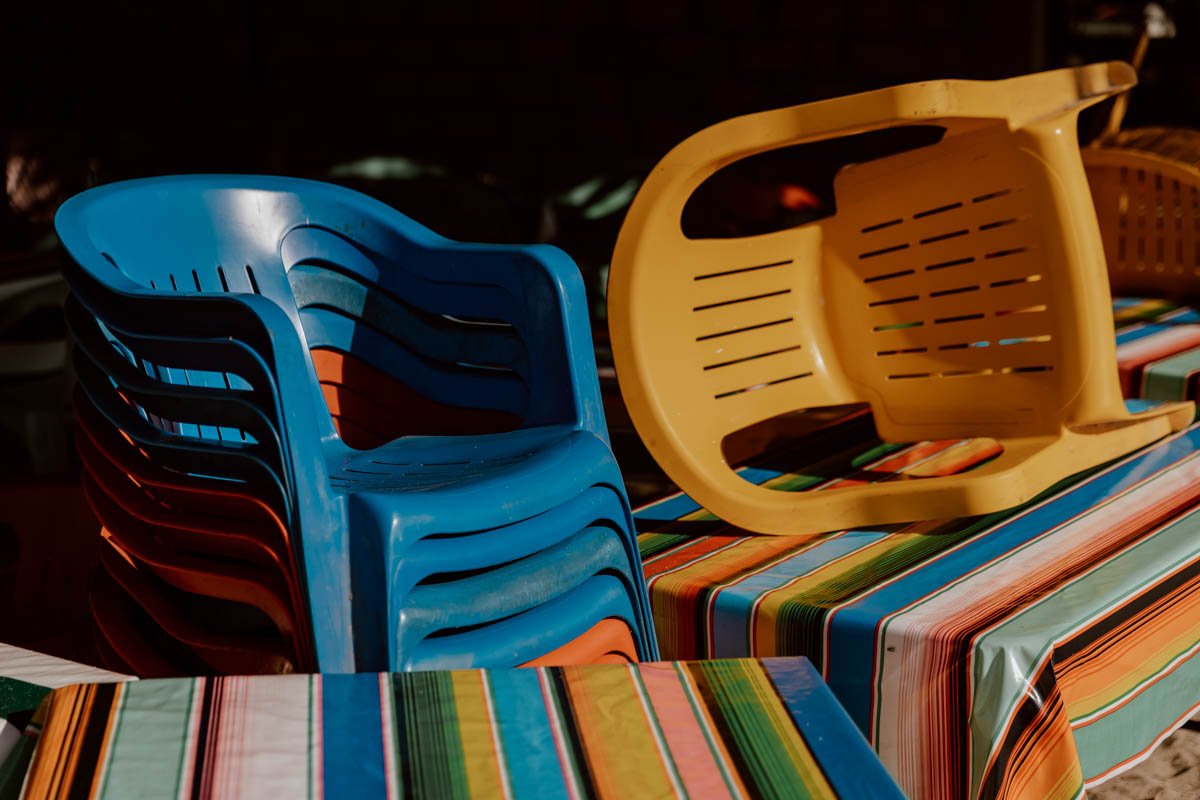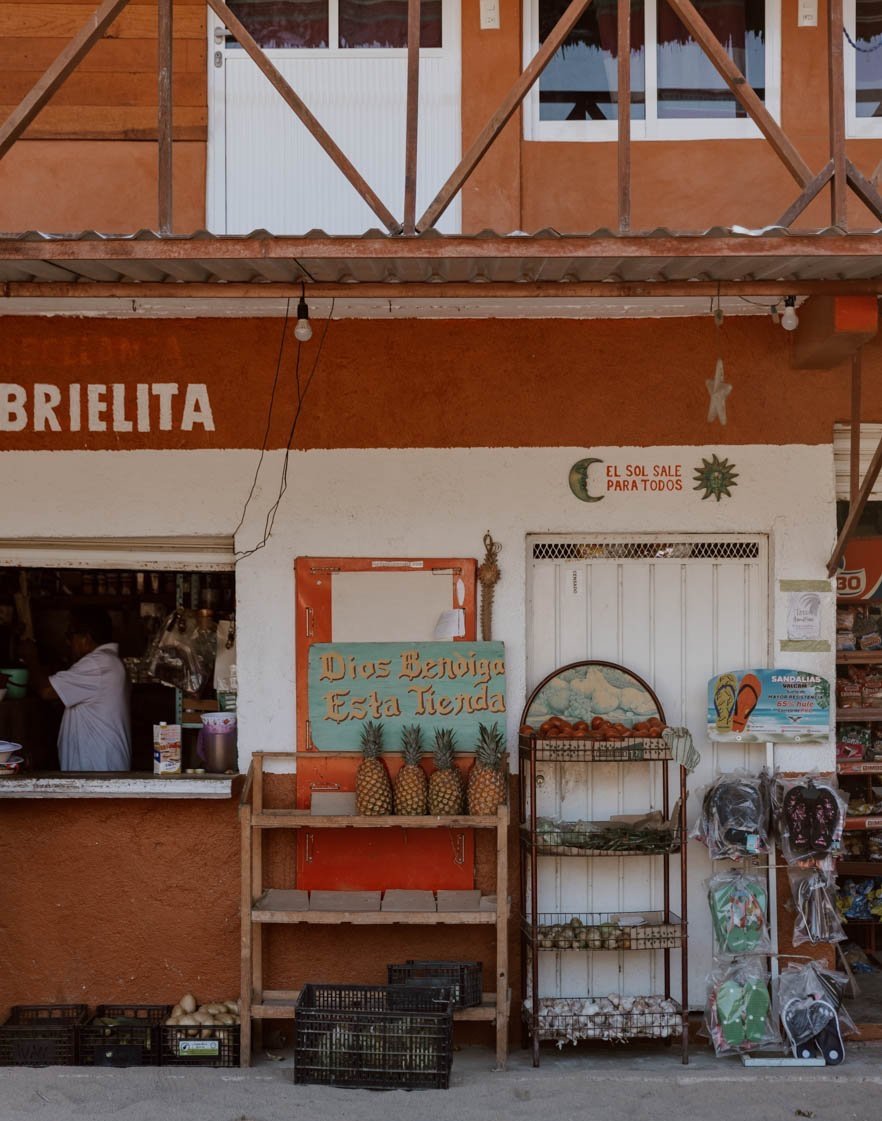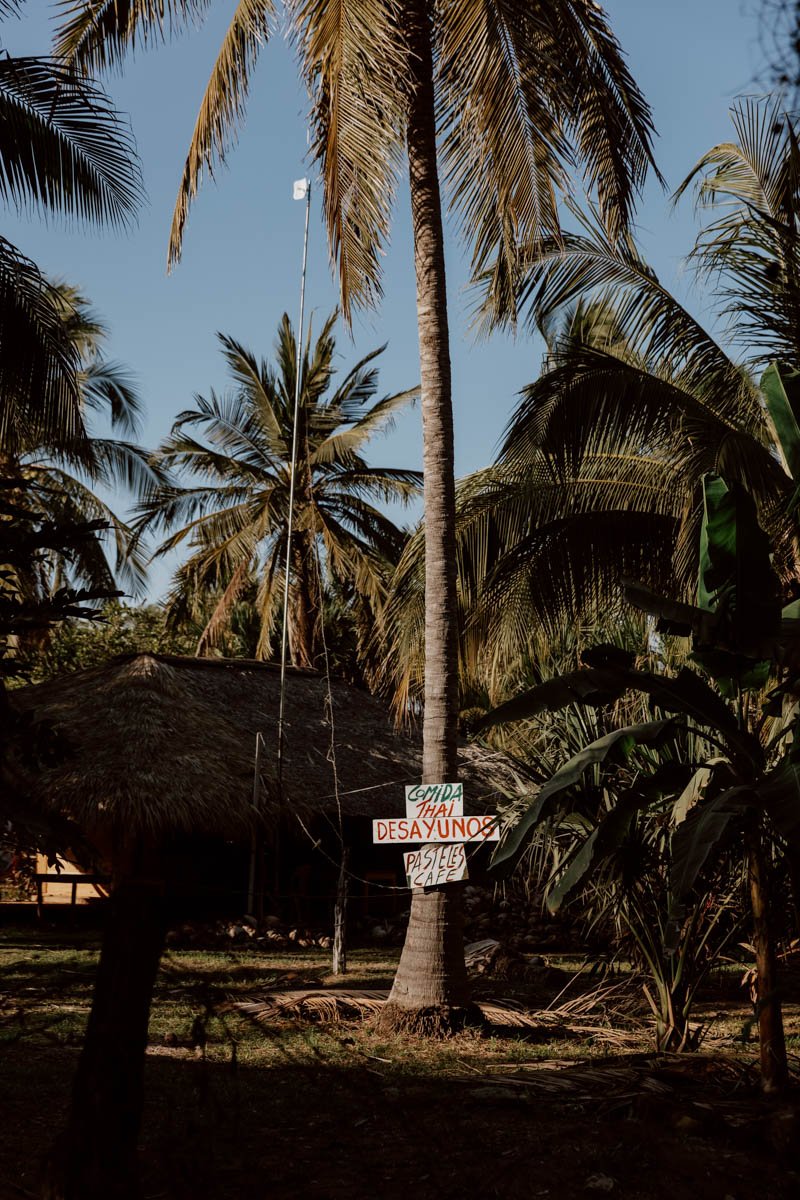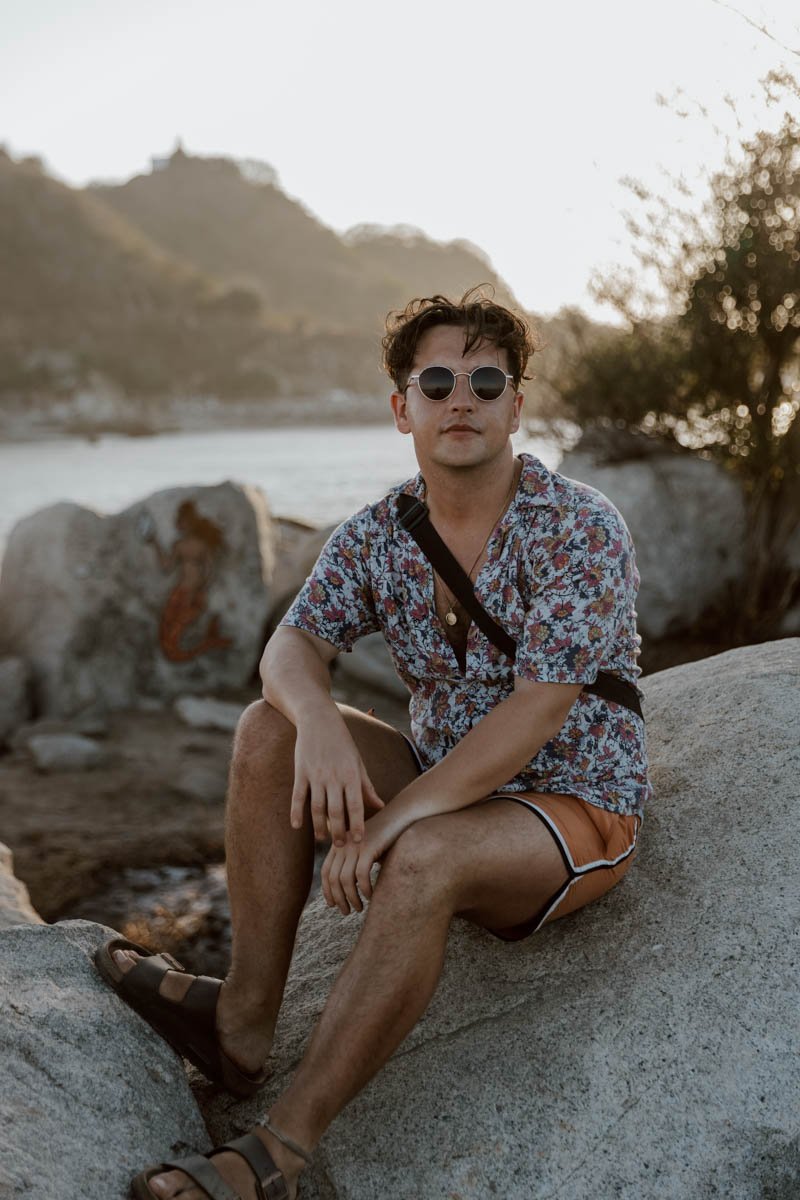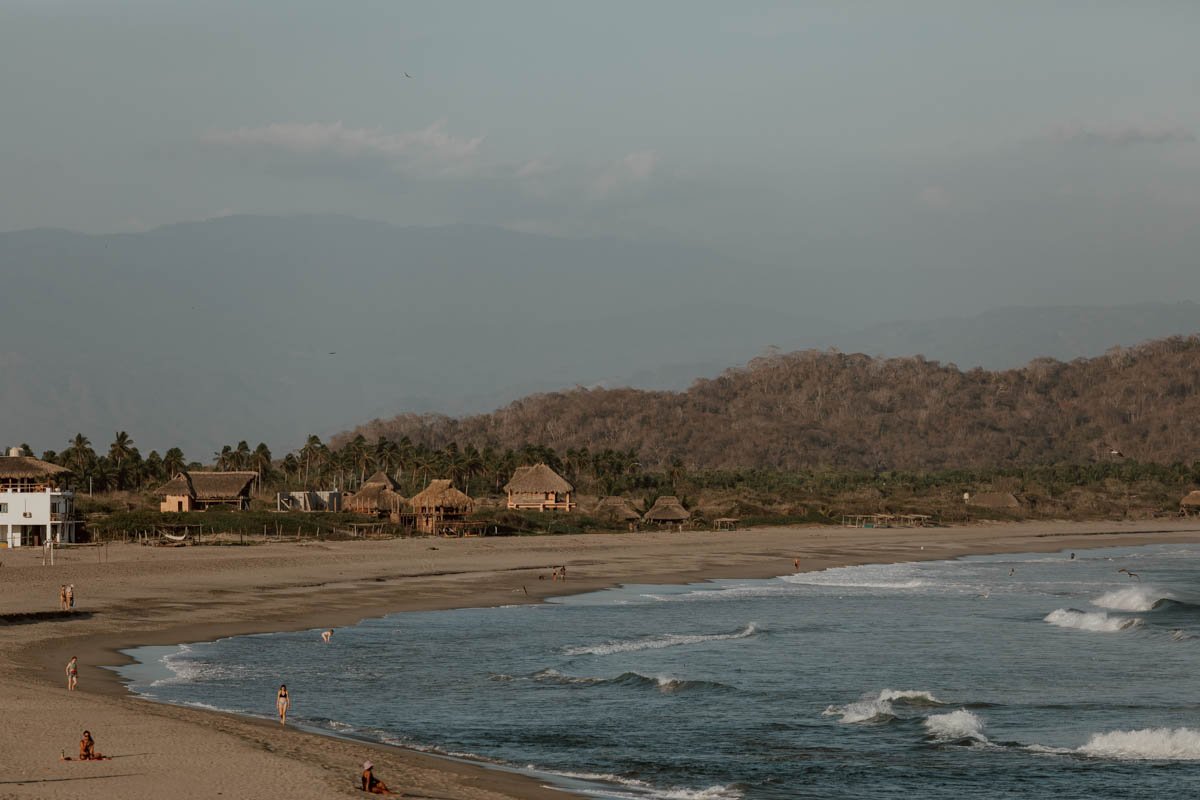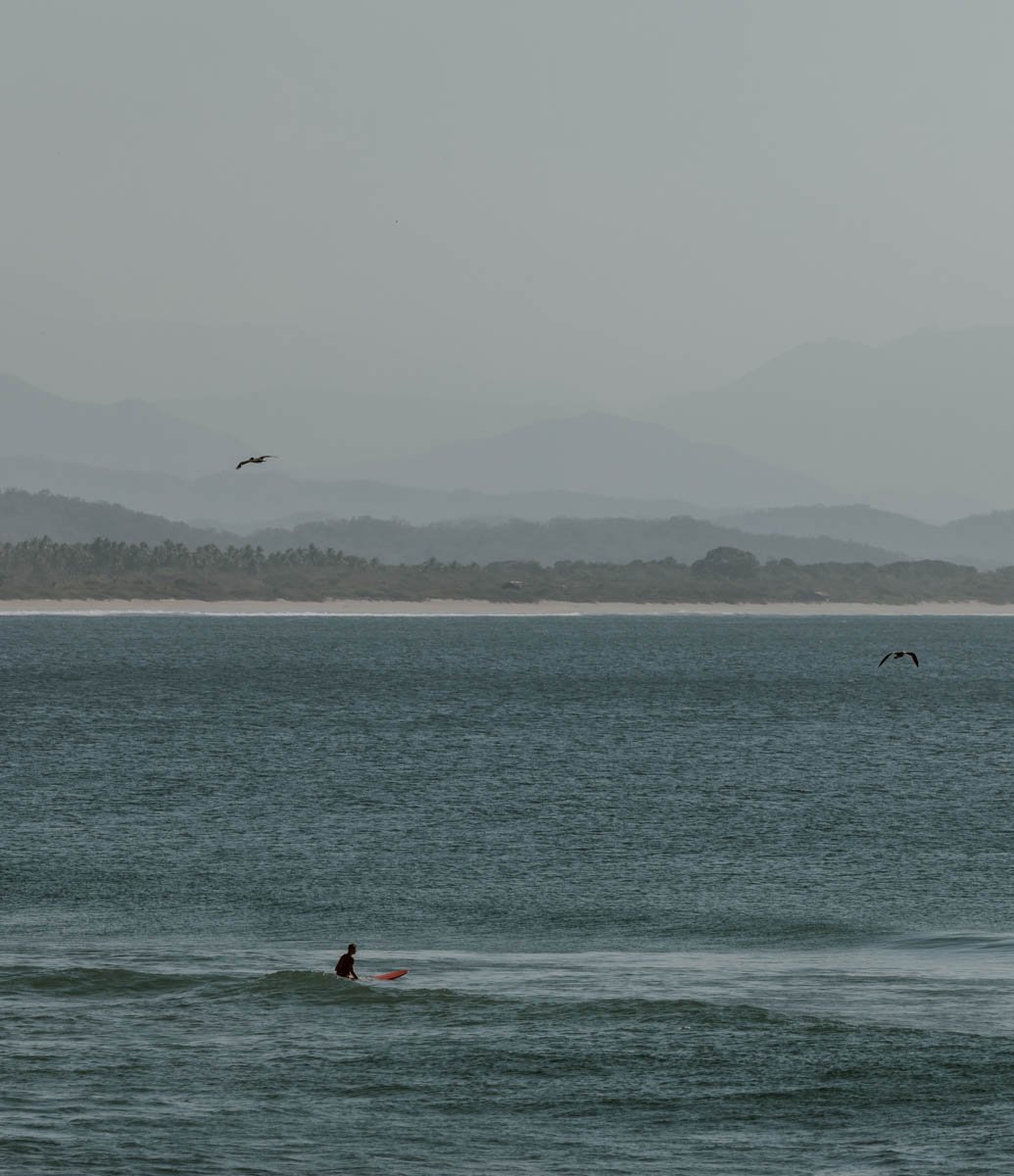Planning a trip to Laguna Chacahua, the magical island behind the mangroves? There’s a few really important things to know before you go to this remote, low-key Mexican surf spot - our guide’s got you covered!
The surfers must get really annoyed.
They seek out a chilled out place by the coast with decent waves and little tourism and then, a few years later like seagulls following the trawler, the travellers arrive after their old favourite place has become too 'touristy'. Then that quiet place by the coast becomes more popular, the prices go up, the vibe changes, and the tourists arrive.
You can cut and paste that cycle all over the world, and the end result is that the surfers end up moving again.
The good news is that, though the cycle of change is inevitable, it's going to take a while for that to hit Lagunas de Chacahua.
Remote, protected, and relatively difficult to reach in comparison to other beaches on the Oaxacan Coast, its geographical, logistical, and infrastructure 'disadvantages' for mass-tourism development turn into big 'advantages' for travellers searching for something completely different.
Somewhere special.
With at least three modes of transportation involved on the shortest route in - this traffic-free Afro-Mexican fishing village composed of dusty roads between the mangroves and the sea is pure heaven for surfers, people in no rush to leave, slow travellers, and those looking to find a place far away from it all behind the blue mountains.
This off-grid island that isn’t really an island and is no longer a secret lies within the protected Lagunas de Chacahua National Park. Days pass slowly, set to the rhythms of the catch, the sunshine, and the surf. Most accommodation remains rustic and basic on the beachfront with mesmerising, uninterrupted sea views. Some stay here for weeks or months, whilst others may find the lack of mobile signal and reliable wi-fi enough after three or four days.
For some travel styles or trips, Chacahua may not be the right sort of destination at all.
In this guide, we've shared everything you need to know before you visit Lagunas de Chacahua, the main community and destination within the park, and how to make the most of your time there. With no ATMs and limited wifi, you do have to do a little more old-school planning + prep than usual, and we've shared lots of essential travel tips from our own experience.
We’ve also shared lots of inspiration + information on where to stay, the surf, typical costs, sunset spots, the best places to eat, transport connections, and why you need to take the more expensive boat once within the national park.
Change will come to Chacahua, but its pace will be slower and more sustainable than elsewhere; enjoy it while you can.
The Chacahua essentials
What / Village within Lagunas de Chacahua National Park
Do / Great for surfing, swimming, and beach chilling
Money / No ATMs, bring more cash than you think
Stay / Accommodation generally basic, but fancier options are Gitana and CasaUwu
Time / Best to stays for 3+ days or weeks!
Tour / Possible to visit on a day trip from Puerto Escondido - this tour is a good option.
Season / November to April ideal
How To Get To LagunaS De Chacahua, Oaxaca
Before we get started though, it's important to appreciate two things:
1. arriving in Laguna Chacahua takes a little more effort than other places.
2. the small, local community within the national park is seeing an steady increase in tourism, and this brings benefits and issues. Please only travel here if you're going to be a respectful, considerate, and responsible visitor.
It’s possible to start out from Zipolite and Mazunte, but to reach Lagunas de Chacahua all roads lead to the popular town of Puerto Escondido where you’ll take a colectivo van, then a jeep, and then decide between one of two boats through the mangroves of Lagunas de Chacahua Parque Nacional.
It takes about 3 hours if you get lucky with connections, and due to this, we absolutely do not recommend travelling to Chacahua independently on a day trip (trust us, you'll want to stay longer than that).
We've covered all the transport + route costs and details in this post: How To Get To Laguna Chacahua
For shorter stays, it's a good idea to leave you big bags back in Puerto Escondido if you can, and we recommend setting off earlier than you think - especially if wishing to take the long lancha. This allows you to enjoy the most beautiful sections of the journey, saves costs, and enables you to grab decent accommodation if you haven't booked anywhere online in advance and have standards.
If are looking to visit Chacahua National Park on a day trip tour from Puerto Escondido, two options include:
Lagunas de Chacahua Day Trip and Boat Ride | This includes a boat ride and bird spotting through the mangroves, time at the beach, a wee sunset hike and a chance to swim amongst bioluminescent waters. It is pricy though. Find out more here.
Chacahua Lagoon Day Trip | This tour has more of a focus on the mangroves, and visiting various little islands within the lake before arriving at Chacahua for beach time. It’s also a fair bit cheaper. Find further details here.
Layout + Getting Around Laguna de Chacahua
In terms of layout, Chacahua can be split into the ‘busy’ side of the beach where most of the village amenities and activity is found (here on Google Maps). It’s also where a lot of the accommodation options are situated, including the highly-rated Cabañas La Isla Chacahua.
Then you have the lagoon side just next to that, where you’ll find a few houses and cabaña, plus the rocky pier and port where the boats arrive in from /depart for Zapotalito.
Beyond that, you’ve got the middle section of the beach where there are some accommodations (like Nattivo), surf camps and not much else, and then it keeps going and curving on the more remote ‘far side’ of the beach toward the blue mountains in the distance.
There are fewer accommodations on the ‘far side’, but the popular Pora is one to check out if looking for a more secluded but accessible setting.
In total, Chacahua beach is a mind-boggling 12km long, so that hopefully that gives you some sense of perspective; most of your time will be spent in and around the first 3kms.
The village continues from the ‘busy’ side of the beach in a couple of directions along several dusty roads (which the colectivo pick-up truck travels upon), and you can cut in to the beach from these at several points too.
Most of you will be based on the ‘busy’ side or the lagoon side, but cabins and campsites in more secluded areas in the middle or far end of the beach will require a 15-30 minute walk in/out along the beach or the dusty road. Alternatively, you can take the colectivo truck and get dropped off nearby.
Apart from that walk, everything’s really close together. With no taxis or cars, you’ll be happily getting around everywhere and anywhere on foot.
Things To Do In Laguna Chacahua
Beyond nothing at all, reading a good book in a hammock, or surfing you mean? Ah, well that's a good question...
Coming to Chacahua, beyond the surf and the beach, is about disconnecting, hanging out, enjoying the beautiful nature of the surroundings, appreciating the pace of remote village life, cold beers, scratch volleyball matches, sunsets on the rocks, meeting new people, and not too much else.
There are however a few activities to do in order to pass the time, with a big focus being the boat trips and tours elsewhere within the the protected Parque Nacional Lagunas de Chacahua.
Mangroves + Birds Tours | Known for its diverse ecosystems - including an extensive mangrove forest, lagoons, beaches, and tropical forests - Lagunas de Chacahua Parque Nacional covers about 51 square miles. The park's various habitats provide a home for a wide range of plant and animal species, as well as serving as a nesting site for sea turtles and a crucial stopover for migratory birds.
This means it’s always been a place that naturists and ecologically-mind travellers like to visit from Puerto Escondido on day trips (like this one). From Chacahua village, you can also take a boat tour out to explore the lagoons, the mangroves, the park’s different islands - including Las Culebras, El Cura, Pañuelas ,and Nana Jacinta - and go bird-spotting in untouched nature.
There’s also various places offering kayak rental + canoe tours in the lagoon to see crocs, birds and fish.
Travel Tip // Mangroves are something we went from having zero interest in - finding them quite creepy to be honest - to being a little fascinated by after learning much more about their vital role whilst travelling in Rincon del Mar, Colombia and then in Corcovado National Park, Costa Rica.
We decided to take the more expensive direct boat into Chacahua, as that goes through the forest and it’s a stunning and memorable way to arrive, especially the mesmerising flurry of birds flying in front of the boat. If you’re not going to do the tour, that’s why we 100% recommend taking that boat at least once.
You can find out more about that experience and the other route in the How To Get To Laguna Chacahua explainer.
The Chacahua Beach | It’s a cliché, but this is paradise.
If you’re not a surfer you’ll be able to while away your days sunbathing, reading, or walking along the sand. It’s okay for swimming, but there is a bit of current (although not as bad as Zipolite), so don’t go too deep out or be totally unaware of what’s going on.
There is a lifeguard tower, but it’s often not occupied. For weaker or less confident swimmers, we’d suggest always making sure there are some people around before taking a dip.
It’s a long old beach, and you’ll not have to go far to find a secluded spot for yourself. However, don’t go too far: one guy we met - passed out, dehydrated, and sunburnt - had decided to try and walk all the way to the far end of the curve. Turns out, perspective means it’s much, much farther than it looks, and you couldn’t pay us to walk 12km one-way along sand under the peak sun.
As mass-tourism isn’t here yet, the beach is generally clean and litter-free, but there is the inevitable bit of fishing paraphernalia and rubbish floating around; help the community by picking up litter you see as well as leaving no trace yourself.
Travel Tip / The tap water in Chacahua isn’t drinkable, which means many travellers depend on single-use plastic bottles from the shop or their accommodation providing free filtered water refills. We’ve used our Water-to-Go filter bottles on lots of trips in Latin America and elsewehre in the world, meaning we can fill up safely from any tap and reduce our consumption of single-use plastics on the road, and they worked a treat in Chacahua.
You can buy one here or find out more about how they work in this explainer guide to travel water filter bottles
Turtles | A short walk along the beach, you’ll see the wood and chicken wire turtle nesting camp. Here, they protect the eggs and do controlled, responsible releases - ask around to find out when and how you can support the collections, nesting and releases.
There is a Crocodile Biological Centre in the village, but we had some bad reports about conditions so did not visit.
Yoga | Palma Real has a nice spot at the ‘busy’ side of the beach, classes are at 9am seven days a week (restorative yoga Monday to Fridays and Hatha yoga at the weekend). There’s a view of the ocean from the second floor practice area, mats are provided, and it’s MX$150/session. Find it here on Google Maps.
Surfing | Those surfers who first discovered Chacahua were right about one thing; the waves here are some of the best in Mexico.
A long right hand point break, this little village offers decent surf almost all year round but they’re particularly big between May and September (a little too big for many surfers), meaning most of those who come to Chacahua during these months tend to be very experienced.
If you’re still in the process of learning how to surf, we’d recommend visiting between October and April when the waves are smaller and much more suitable for beginners.
As a little side note for newbies, be aware that there are some seriously good local and international surfers in Chacahua, so respect is of the upmost importance. Don’t drop in on them, know who has right of way, and don’t try and surf waves above your level.
Many proper surfers will already have their own board with them (you can bring shortboards on the boat and in the colectivo truck without problem) but others may prefer to just rent one short or long-term here. We’ll defer to Surf-Forecast to give you the technical points on the waves.
You’ll find lessons and rental advertised all along the beach. When we asked around, one-on-one lessons were the surprisingly pricey M$600-700, with board rental costing M$150/hour or M$300/day - for longer rentals or more lessons you will get a better rate.
It’s a good idea to ask around surfers who have been there a while to get an idea on prices before agreeing to anything long-term. Be aware that you will need to swap the board for an ID when renting; absolutely do not hand in your passport!
The Sunset Spots| The most popular place to hang out, watch dozens of surfers, and enjoy the sunset is at the end of the old concrete pier, near the centre of Chacahua. Known as Mirador Laguna, it’s easy to find and a common fishing spot for locals with homemade reels.
It can become quite busy as sunset so, given the need to clamber over some big rocks, you may prefer to head over earlier than you’d assume. Find it here on Google Maps.
The other most frequently visited sunset spot is El Faro (maps), the lighthouse just across the lagoon.
To reach it simply take one of the waiting boats over for 20 pesos per person, walk past the beachfront restaurants until you see a sign ‘Playa El Faro’ and from there hike up the steep set of stairs to the lighthouse for views across the bay.
There will likely be a boat waiting for the return ride, but if not just hang around a little longer or try to get someone’s attention across the water to send one over.
Plan // The Best Beaches in Oaxaca
Bioluminesence | Shimmering stars in the dark ocean, we’ve been fortunate enough to see and swim in bioluminscent plankton in various countries, and you can join nighttime boat trips here. If you’ve never seen or swum in it before, we can highly recommend and doing it in a place as quiet as this would be memorable. Prices are around about M$100 per person and note that the visibility is best just before and just after a new moon as it’s less bright.
Whales & Dolphins | The Oaxacan coast is blessed with these creatures from December to March - we even saw a couple of baby whales from our sunbeds in Zipolite the day we got engaged - and you can head out on a spotting boat trip from Chacahua.
For any boat trips or tours, you can just head to the area around the boat dock and there’ll be guys who offer them or know someone who does. Alternatively, pop into Farmacia Marellita (maps), where they operate a tour agency offering everything we’ve mentioned.
Ping Pong & Pool | Afrodita (maps) was the bar next to our accommodation and a popular spot some evenings due to its excellent new pool and ping pong tables. The latter were free to use if you buy a drink, but the pool tables are 100 pesos / hour. It isn’t open every night though (if you find out the schedule, let us know in the comments).
There’s also the occasional beach party, and you’ll hear about these via word-of-mouth or someone flyering on the beach. Personally though, we hope Chacahua doesn’t become a hub for this type of travel, especially once the new highway from Oaxaca to Puerto Escondido is completed.
A Temzcal | Nothing to do with the booze, this is the name of the traditional medicinal sauna in Mexico. Set within a small hut, it’s basically a sweat lodge but has various traditional rituals and ceremonies involved with it.
You can do one at Casa Venado (maps), relatively hidden away on a back road from the beach. They note the times + availability on the blackboard outside each day - I’m afraid we don’t know the cost - and also do massages, coffee, and tours.
Travel Tip // There is no ATM or bank here, so you need to bring a lot of cash with you. We’ve got more advice, a solution if you run out, and more travel better tips for Chacahua at the end of the post.
Where To Stay in Chacahua
It's really is a small place, and most accommodation options are clustered on the lagoon side and along the beach. There are also a few lesser-known simple guesthouses in the village, but most travellers will want to be on the beach with that superb ocean view each morning.
With that said, it’s your travel style, trip length, and budget that will really determine what's best for you when it comes to accommodation in Chacahua.
An increasing number of properties are now available to book in advance online, but this is still a place many just turn up to and go door-to-door, and where lots of long-termers and budget backpackers choose to rent tents or hammocks. There are sometimes signs up saying ‘disponible’, someone offering passers-by a place to stay, or you’ll just have to knock around and ask (it’s not always immediately clear, but lots of the restaurants also have camping spots and rooms).
We appreciate that finding accommodation upon arrival will be unappealing for some, and after our own search, we know that some private rooms will honestly be too basic or rustic for your travel style.
At the start of Along Dusty Roads, we travelled Latin America for two years on a super-tight budget and stayed anywhere and everywhere, but we are a little more particular about what we will and won't tolerate these days, and can spend a bit more too.
However, in Chacahua, we turned up without a booking, left our big bags at a restaurant, and wandered around to find somewhere half-decent for a few nights.
Several of the places our readers had recommended (like Cabañas Chacahua) were already sold out by the time we arrived, and a few options were either not great or charged too much for what was on offer, so it took us a little longer than expected to settle on a suitable room.
For people arriving and staying here for weeks (or even months), a good idea is to book or turn up and pick somewhere cheap for the first night or two to get a gauge, ask around, and then settle on a good place on a longer-term rate. As ever, haggling isn’t a sport, and it’s important to ensure everyone comes away with a fair deal.
If booking online, you will tend to pay more than turning up on the day, but there are pros to certainty and time saved on shorter trips here. If you're only going to be in Chacahua for two or three nights and looking for a room that's nicer, brighter, lighter, more romantic, and doesn't have a dozen backpackers camping underneath you, then we do recommend having a look at what's available online + booking something in advance of your arrival.
Booking online also removes the need to carry even more cash with you from Puerto Escondido.
Note, if you're a surfer or slow traveller with the flexibility of a long-term trip, then you will almost certainly want to stay longer here than you anticipate. Therefore, be cautious about having a defined itinerary or non-cancellable accommodation / experience booking in place for your next stop in Mexico. Chacahua’s definitely an extender!
We know that choosing the right accommodation can sometimes feel like an arduous task, so we've done the hard work for you and shared a selection of the best Laguna Chacahua accommodation we found on our wanderings and available to book online. Note that, when booking somehwere online, just double check that you're comfortable with how far a walk along the beach it is, or contact the property/host to confirm the best way to reach it.
Porã Chacahua | Exactly what some of you will be looking for, this place has thoughtfully-made teepees and tents plus eco-credentials. If you want a traveller vibe but prefer nicer accommodation, this relatively new and secluded spot is a good pick. Veggie/vegan breakfast offered and shared kitchen available to use afterward. The only two things to be aware of is that Porã is a good 30-minute walk along the beach from the main town, or you can take the colectivo truck and get dropped off nearby. Find out more here.
Casa UwU | Probably the most expensive option here, and one that hopefully isn’t the harbinger of what Chacahua will be covered with in a decade. However, these beach front villas are, undeniably, truly stunning. All beautifully designed, there’s a strong bouji Tulum vibe throughout, and the deluxe villa even has its own private plunge pool! You can book here, but it’s also available on Airbnb:
Villa Tortuga | Beachfront Villa | Villa Guayacan
Chacahua Surf Camp | This was one of the most popular options for backpackers and surfers, with good mix of rustic hostel and campsite. Doesn’t appear possible to book online though, so it’s a case of turning up and checking availability.
Note that camping spots on the island are typically around 50 pesos per night, but are sometimes free if you consume a certain amount of food/drink; shared bathroom facilities range from very basic to acceptable. If there’s a campsite you recommend, let us know in the comments.
Casa Gitana | Stylish with a rustic and contemporary aesthetic, this boutique guesthouse is probably one of our favourites. The rooms are on the small side, but each opens up directly on to the beach so you gain a sandy terrace with a chairs / swings. Well-located and a great option for couples. Find out more here.
Cabañas Alta Mar | Fantastically located near the centre of the village, they offer large comfortable and clean rooms (the deluxe double with sea view would be our pick), a terrace and sun beds / parasols for guest use. People speak super highly of the owner, Diego. Find out more here.
Hotel Sanmara | There are’t really traditional or large hotels here, but if comfort and a big, clean modern room is your priority, this hotel may be perfect for you. Tastefully decorated and offering comfortable interiors with a fantastic private seaview terrace to boot. Ideal perhaps for older travellers who’d rather be away from the tents and backpacker crowds but still in a good location. Check availability here.
The same owner also has Nattivo Ecoglamping next door, offering little wood and palm teepees and a guest pool. Also available to book on Airbnb.
Others to consider include Cabañas La Isla Chacahua for its amazing location on the beach, Cabañas las Palmas Chacahua for its decent priced double (and pretty decent apartment), Nature Lodge for its excellent value doubles, El Piojo, and Nahualcali Chacahua for a truly off-grid experience. Our private room was on the top floor of Cabañas Afrodita, but it doesn’t look like it’s possible book online.
Where To Eat & Drink
You can enjoy excellent, homemade staples like tlayuadas, sopes, huevos divorciados, chilaquiles (a big ADR favourite), and plentiful portions of locally-caught fish and camarones. There are also a handful of spots serving up more traditional global backpacker fare of burgers and pizzas, and usually people walking around selling various foods along the beach.
You’ll always end up eating in or around the dusty ‘main square’ (maps) or somewhere on the beach, and should budget about M$80 - 120 for breakfasts and M$150-200 for lunches and dinners.
A few to make a note of are:
The tlayudas and sopes places | In the square, you’ll see two shack restaurants serving up tlayudas, sopes, and other traditional Oaxacan dishes. The place on the top right hand side, next to the Piña Colada corrugated iron shack bar with the best-designed sign in the world (nude lady with the python), wasn’t that good, and we thought the place opposite it was better.
Restaurant Bertitha (maps) | A popular option on the short road into the dusty main square, especially at breakfast. The menu didn’t massively appeal to us though.
Chacahua Wings (maps) | Next to Gabrilita Tienda, as the number would suggest, it’s got wings, burgers, fries etc.
Isela Restaurant (maps) | Located along the dusty back streets, this little restaurant serves up good sized portions of traditional Mexican dishes. Being away from the beach, prices tend to be a little lower too.
4-20 Coffee Shop & Sushi Bar (maps) | This place wasn’t yet open when we visited but the reviews are so incredible, we had to include it. Taking advantage of being able to catch fish on their literal doorstep, they specialise in sashimi and ceviche - with a healthy number of vegan and veggie dishes as well. Its location also guarantees incredible views.
The Burger Place | On the beach run by some cool surfers, this is a great spot for a few Victorias and a burger at night. We both had the fish burger (which was excellent) but the veggie options is also super popular. We cannot for the life of us remember the name, but it was to the left of Tortuga Feliz.
Restaurant El Ponto | In all honesty, we’re not certain that’s the name as their sign involves a jug and a coconut at the end which may be an ‘o’ or simply a coconut. However, it’s a good spot for a few beers and a chilled out lunch between your sunbathing or surfing.
Restaurant Frente al Mar | Something for everyone in a nice beachfront setting, and a good spot for a sundowner. You can pay with card too.
Elena Montes | On the beach, it does pizzas in the wood-fired oven, but we didn’t have one.
Service in Chacahua is usually pretty laid-back (i.e. slow) at the cafes and restaurants, so if you’re really hungry or need something quickly, it’s best to take a breath first.
For groceries, there are the two mini-markets in the main square for snacks and supplies, but for more variety or options on long-term stays, you may need to go into Rio Grande (see below).
Chacahua also strikes us as a place that a fruit truck would turn up in some days.
Parque Nacional Lagunas de Chacahua | Essential Travel Tips for Visiting
· There is no bank or ATM in Laguna de Chacahua or the immediate surroundings, and the majority of businesses are cash-only. This means you have to do multiple withdrawals and stockpile money before you arrive.
· As many travellers extend their stay, this also means you really do need to take out more than you expect to spend to give yourself a 'buffer' beyond your standard emergency cash buffer.
Regardless of your travel style or how long you're staying, we recommend working out how much you think you'll need each day of your stay, and taking enough for an extra couple of days and emergencies.
· The most convenient place to withdraw cash prior to setting off is the massive Chedraui supermarket in Puerto Escondido (maps). A short walk from the Terminal TUR, it has about eight different ATMs from various banks, so one is always guaranteed to be working and not to charge an extortionate withdrawal fee ($19-40 pesos is reasonable).
For our British Starling bank cards, the HSBC machine only charged MX$35.84 and we could withdraw up to 6,000 each time. Bear in mind that your account will have a max. daily withdrawal limit, which is why it’s good to have more than one, otherwise you’ll need to start stockpiling 24-48 hours earlier.
· If things go wrong, you plan to stay much longer, or you're faced with an unexpected emergency whilst in Laguna Chacahua - don't panic. There are three solutions:
1. At the big shop in the dusty town 'square' - Supercito Christian (maps) - you can use your card to get cashback via his card machine. However, he will charge you 10% commission, so taking out M$2,000 will cost you M$2,200 on the transaction. Once the payment's gone though, you'll get the cash from the till.
This is the best option if you're short on time or just need a top up of a few thousand pesos to tide you over. We recommend lumping in this transaction with the purchase of any shopping too, as he lets people include it on the same payment at no additional cost*.
2. Take the regular colectivo truck from the dusty town square (or elsewhere along the road out) to connect to the boat, and then jump in a passing minivan to take you to Rio Grande (maps). This is the closest town to Laguna de Chacahua, and locals follow this route to do business, groceries etc.
It works out at about M$240 pesos round-trip on the transport (plus any withdrawal fees), and you'll lose a morning or part of an afternoon, but it enables you to withdraw larger amounts and the overall cost will be significantly lower than the tienda's 10%.
According to long-termers we chatted to on the way out, this is the cheapest overall option despite the transport costs + time, and some people even do money runs for others to the town!
See the 'How To Get From Chacahua To Puerto Escondido' section later in the post for more details on the specific transport + connections as you'll also do this route when leaving.
3. Wherever we travel in the world, we always keep a store of crisp US dollars for emergencies. In a jam, it's going to be the easiest currency to exchange or use, but it's ideal in Mexico. If funds are low, you'd probably be able to find a business or other traveller to swap some for pesos.
As more businesses change and internet connections improve, stockpiling will be less of a requirement, so do let us know in the comments when things change...
*lots of businesses in Oaxaca still charge 5% in addition for any card payments, as that's what the bank charges them and they simply pass the cost on to you. It can be a pain, but that's the situation at present.
· As mentioned, investing in a filter water bottle for Mexico and other travels is great idea - find out more in this post or buy a Water-To-Go here (use ADR15 for a 15% discount)
· Bug spray at night is essential. We use and recommend Incognito, which is DEET-free, cruelty-free, 100% plant-based, and really works.
· Also stock up on suncream and any other essentials or specialist items you need for shorter or longer stays.They do sell it here, but it’s understandably more expensive and limited in range. Again, the massive supermarket in Puerto is a convenient place to do this alongside taking your cash out before jumping on the minivan to start the journey from Puerto Escondido to Chacahua.
· Most accommodations and restaurants do not currently have wifi. We had Mexican SIM cards, but rarely had an internet connection in Chacahua, and when it did appear, it was terribly slow. Some places that advertise wifi don't have a connection that's reliable, or the speed won't be better for anything other than basic stuff.
There is however Starlink at Totuga Feliz, and that's what anyone based here and doing some work relied upon, but digital nomads should be cautious about how long they can be here.
· Therefore, take the opportunity to enjoy that luxurious, harder-to-find-than-ever-before opportunity to disconnect. Bring a book, download your podcasts in advance, and forget about streaming for a few days. Go old school, play pool, drink beer, and make friends.
· As mentioned, if arriving from Puerto Escondido for just a few days, it's best to leave your big backpacks at your hostel there, and only take what you need. The boats and colectivos don't have lots of room, but you'll also have to carry everything you bring to accommodation at the far end of the beach. It’s really not a good idea to arrive here with suitcases.
· There are a few places offering laundry service, including Doña Tomasita’s place where it’s MX$120 for a dozen items.
How To Get From Chacahua To Puerto Escondido
Once you've finally decided to leave, or run out of money, you have two transport options. As with the journey into Laguna Chacahua, you can take the more expensive direct boat through the mangroves, or opt for the cheaper truck+boat combo.
We’ve shared the details of the latter below.
Leaving Chacahua
· The first camionetta truck leaves from the dusty main square at 6am or 7am - we were told two different times by locals, so double check if heading out early! When were there, the departures were then every hour at 20 past the hour (i.e. 7.20 am, 8.20 am, 9.20 am etc etc).
He beeps his horn when arriving into the square and when he's just about to leave, so if you hear a horn, it's best to get a move on.
Our truck eventually left the square at 11.30am with eight passengers, and roughly ten minutes later, there were closer to seventeen of us (an even mix of locals and travellers squeezed in the truck and hanging on at the back). He picks up all along the dusty road from the square and through the village, so there may be easier places to arrive + wait than in the main square from certain accommodations.
However, you're far less certain of a seat and the space to get your big backpack up on rack; many picked up later just hang on to the back of the truck!
If we had lots of stuff with us, we'd definitely prefer get on at the square to save hassle and guarantee a seat in the cabin or back. When it fills up though, do not hesitate to shuffle up or give up your seat if there's a local more in need of it than you.
The driver will drop you off in a gorgeous little spot, where there's usually a small colectivo boat waiting. It can only take 10-12 people, so you may have to wait around for 20 minutes for him to return.
It was 50 pesos per person for the truck, paid to the driver, and journey time is 30-45 minutes depending on how many people get on / off along the way. For the boat, it was another M$50 per person, and travel time of 10 minutes.
2. Alternatively, you can take the 45-minute direct boat from Laguna Chacahua. You will find the guys waiting on seats near the lagoon side, but they require a minimum of five people for journeys at M$300 pesos per person. If there's a large group of you waiting, the price may come down.
We recommend taking the more expensive direct boat to arrive, and the cheaper truck+boat combo to leave. Travel time is quite similar for each, but the experience of slowly going through the mangroves is definitely worth it on arrival if you're not on a super tight budget.
The Crossroads To Puerto Escondido
There was a red-and-white colectivo truck waiting at the port to take us to the crossroads. The price depends on the driver, and it’s either M$20 or M$25 each for the five-minute journey.
Once the red and white colectivo drops you off at the crossroads (here on Google Maps), it's a case of waiting for one of the frequent minivans to stop. They're likely to be quite full already, and it's up to you whether you're happy to squeeze in for a back seat or wait for an emptier one.
The cost per person from the crossroads to the TUR terminal in Puerto Escondido is MX$70, and travel time is about an hour.
From that terminal in Puerto Escondido, you can jump in the back of another colectivo truck to Zicaleta or La Punta (about $15 pp) or hail a cab (about $70 pesos to La Punta)
For more advice on the journey in, or step-by-step details for each stage, head over to this post: How To Get To Laguna de Chacahua.
Your Next Stop?
How to Get to Laguna de Chacahua
Our Favourite Things to Do in Puerto Escondido
A Traveller’s Guide to Zipolite
A Travel Guide to Puerto Angel
Useful Things to Know Before Travelling the Oaxaca Coast



